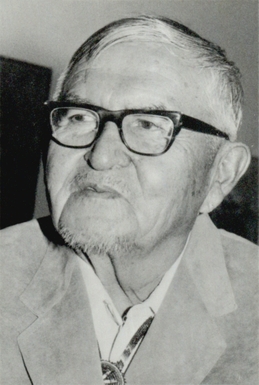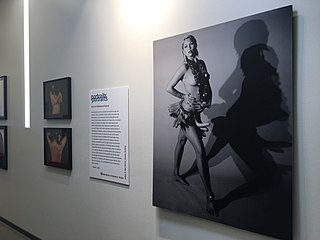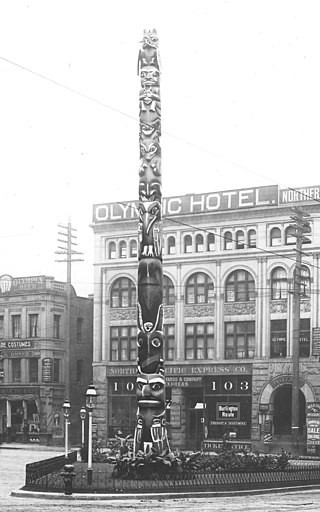
The Tlingit or Lingít are Indigenous peoples of the Pacific Northwest Coast of North America and constitute two of the two-hundred thirty-one federally recognized Tribes of Alaska. Although the majority, about 14,000 people, are Alaska Natives, there is a small minority, 2,110, who are Canadian First Nations.

Totem poles are monumental carvings found in western Canada and the northwestern United States. They are a type of Northwest Coast art, consisting of poles, posts or pillars, carved with symbols or figures. They are usually made from large trees, mostly western red cedar, by First Nations and Indigenous peoples of the Pacific Northwest Coast including northern Northwest Coast Haida, Tlingit, and Tsimshian communities in Southeast Alaska and British Columbia, Kwakwaka'wakw and Nuu-chah-nulth communities in southern British Columbia, and the Coast Salish communities in Washington and British Columbia.

The Mitchell Museum of the American Indian is a museum in Evanston, Illinois that focuses exclusively on the history, culture and arts of North American native peoples. It is a Core Member of the Chicago Cultural Alliance, a consortium of 25 ethnic museums and cultural centres in Chicago.

The Institute of American Indian Arts (IAIA) is a public tribal land-grant college in Santa Fe, New Mexico, United States. The college focuses on Native American art. It operates the Museum of Contemporary Native Arts (MoCNA), which is housed in the historic Santa Fe Federal Building, a landmark Pueblo Revival building listed on the National Register of Historic Places as Federal Building. The museum houses the National Collection of Contemporary Indian Art, with more than 7,000 items.

Allan Capron Houser or Haozous was a Chiricahua Apache sculptor, painter, and book illustrator born in Oklahoma. He was one of the most renowned Native American painters and Modernist sculptors of the 20th century.
Nathan Youngblood is a Native American potter from Santa Clara Pueblo, New Mexico, United States.

The visual arts of the Indigenous peoples of the Americas encompasses the visual artistic practices of the Indigenous peoples of the Americas from ancient times to the present. These include works from South America and North America, which includes Central America and Greenland. The Siberian Yupiit, who have great cultural overlap with Native Alaskan Yupiit, are also included.

This is a chronological list of significant or pivotal moments in the development of Native American art or the visual arts of the Indigenous peoples of the Americas. Earlier dates, especially before the 18th century, are mostly approximate.
Robert James "Jim" Schoppert was an Tlingit Alaska Native artist and educator. His work includes woodcarving, painting, poetry, and essays. He has been described as an innovator, whose works pushed the boundaries of what was expected from Northwest Coast art.

Nathan Jackson is an Alaska Native artist. He is among the most important living Tlingit artists and the most important Alaskan artists. He is best known for his totem poles, but works in a variety of media.
Larry McNeil is a Native American photographer and printmaker. His photographs range on subjects and formats from realist portraits to tribal elders, from abstract cityscapes to electronic manipulations of tribal environments. His images are considered personally meaningful as they are representative of tribal realities and highlight the sensitivity behind the representation of Native Americans.

Nicholas Galanin is a Tlingit and Unangax̂ multi-disciplinary artist and musician from Alaska. His work often explores a dialogue of change and identity between Native and non-Native communities.

Erica Lord is an Alaska Native artist, based in Santa Fe, New Mexico, who identifies herself as a mixed-race "cultural limbo."
Corrine Hunt, also known as Nugwam Gelatleg'lees, is a Kwakwaka'wakw/Tlingit artist, carver, jeweller and designer based in Vancouver, British Columbia, Canada.

The Pioneer Square totem pole, also referred to as the Seattle totem pole and historically as the Chief-of-All-Women pole, is a Tlingit totem pole located in Pioneer Square in downtown Seattle, Washington.
Jackson Polys is a Tlingit Native visual artist and filmmaker whose work is based between Alaska and New York. His work examines the constraints and potential in the desire for Indigenous advancement, while challenging existing gazes onto traditional Native culture. Polys is well known for his films, institutional critique, and carved sculptures incorporating materials such as abalone, glass, liquids, resins, silicone, as well as the ready-made.

Sandy Fife Wilson is a Muscogee (Creek) art educator, fashion designer and artist. After graduating from the Institute of American Indian Arts and Northeastern Oklahoma State University, she became an art teacher, first working in the public schools of Dewey, Oklahoma. When Josephine Wapp retired as the textile instructor at the Institute of American Indian Arts, Wilson was hired to teach the design courses. After three years, in 1979, she returned to Oklahoma and taught at Chilocco Indian School until it closed and then worked in the Morris Public School system until her retirement in 2009.

Vicki Lee Soboleff is a Haida and Tlingit artist, dancer, and teacher who specializes in Haida basketry. She was awarded the Margaret Nick Cooke Award in 2016 from the Alaska State Council on the Arts and the Alaska Humanities Forum for her work with Alaska Native dance.
Ursala Hudson is an Alaska Native textile artist, graphic designer, and fashion designer. She also photographs and paints. She creates Chilkat weaving, including dance regalia, belts, collars, and earrings.












